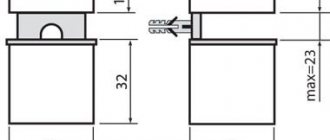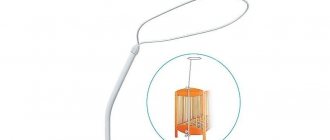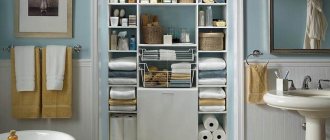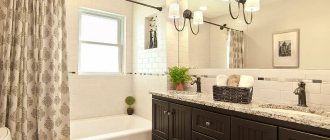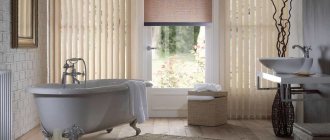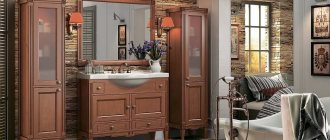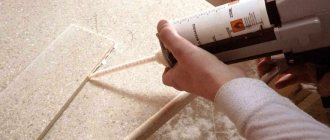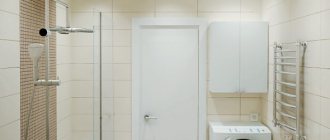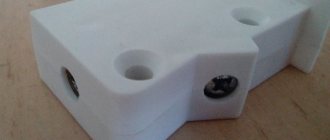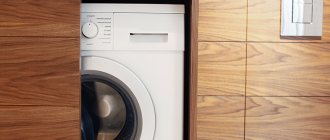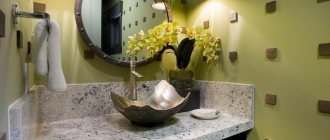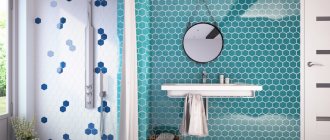A seemingly simple thing, a curtain rod for a bathroom is now available in several versions and choosing it can be difficult. Let's look at all the popular models together, and home craftsmen will receive 3 step-by-step instructions for installing a curtain rod in the bathroom with their own hands.
If the curtain rod in the bathroom doesn't stay on, then it's time to change it.
Types of rods
If several decades ago the shape of the cornice was standard, the same for everyone, now there is a wide variety of models in stores. Types of bathroom rods are divided by shape and method of attachment.
By form:
- classic straight;
- corner - with a right angle, semicircular fastenings for curtains;
- ring – additional mount for shower. Ideal for freestanding bathroom bowl;
- made to order - made to suit exclusive bathtub models.
By mounting method:
- telescopic – mounted between walls;
- on dowels to the walls;
- fastening for curtains in the bathroom to the walls with screws - with an additional suspension to the ceiling;
- ceiling mount.
Features of installation on different surfaces
On concrete walls lined with tiles
To secure the rod to the tile, you first need to make sure that the cladding is strong. If the tiles are weak, the seams are crumbling, traces of fungus are visible on the surface, you cannot attach anything to the wall. First you will have to dismantle poorly secured elements, remove any remaining glue, clean out the seams and re-face everything.
Removing tiles
Laying new tiles on the wall
If the tiles hold up perfectly and there are no defects, you can immediately begin the installation process. You should immediately take into account that the hammer drill mode is not suitable for tiles; they may become covered with cracks. You also need to take a different drill - with a spear-shaped tip, which will allow you to make very neat holes.
Tile drill bit with spear tip
Operating procedure:
- In the designated places, stick a small piece of masking tape onto the tile. Then the points for drilling are placed directly on the tape;
- A spear-shaped drill is inserted into the drill and holes are made at low speeds to the concrete base. From time to time, the tip of the drill is dipped in cold water to avoid overheating;
Be sure to turn off the impact mode of the drill and select the mode with the lowest speed
How to drill tiles in the bathroom
- when the tile is drilled, change the drill and continue to go deeper into the wall to the desired mark;
- squeeze a little silicone into the hole, insert a dowel and fasten the bracket.
Everything else is done according to the technology described above.
On drywall under tiles
As a rule, walls and partitions made of plasterboard adjacent to the bathtub are tiled. Paint and waterproof plaster under direct exposure to water cannot provide reliable protection to such material, unlike tiles. But this design makes it a little more difficult to attach accessories, as it requires special care.
To drill the cladding, it is recommended to use a diamond drill, which makes it possible to make a hole without strong pressure on the surface.
Diamond drill
Instead of standard dowels, butterfly dowels are used.
Dowel
If the rod is large and heavy, the fasteners in the drywall will not withstand the load and will become loose over time, which means that you need to drill deeper - to the concrete base. In this case, the fasteners also need a large length, taking into account the thickness of the drywall, tiles and the gap between the gypsum board and the wall. The kit usually includes self-tapping screws measuring 5x40 mm, so you will need to purchase separately self-tapping screws of the same diameter, but 80-100 mm long. The dowels, accordingly, should have a diameter of 6-8 mm and a length of 80-100 mm.
The marking is carried out as standard, as on other surfaces. A drill should be at least 10 cm long and must be sharply sharpened. You need to drill at low speeds (1000 rpm), holding the tool firmly and preventing it from slipping. Having drilled through ceramics and drywall, the drill is changed to a Pobedit one and continues to go deeper into the concrete. After this, the rod is mounted on the dowels.
We make a hole in the gypsum board, insert a dowel, and fasten the product with wood screws
The diameter of the hole must be selected in such a way that the dowel fits in tightly and does not turn itself when tightening the screw.
After tightening the self-tapping screw, you get this kind of stop on the back side
On plastic panels
Installing the rod on plastic-lined walls is quite simple. Plastic is not afraid of vibrations and is easy to drill. Here, too, you need to use long dowels, since you cannot attach the rod to the plastic itself - it simply will not withstand the load from the cornice and curtain, and the fasteners will tear out of the sheathing. So, take a regular drill and make neat holes in the plastic at high speeds. Then the concrete is drilled using a Pobedit drill in hammer drill mode. When fixing the product with self-tapping screws, it is very important not to overtighten them, otherwise the plastic will be deformed and may subsequently crack.
Installing a dowel on a wall covered with plastic panels
If you plan to install the rod in a spacer, keep in mind that thin plastic will bend and be pressed under such influence. It is best to prepare a stop for the rod at the stage of wall covering: at the location of the rod, fix two strong boards on the wall to the thickness of the sheathing. Otherwise, to avoid pushing through the plastic, the rod will have to be mounted on dowels.
The bar is installed in a bathroom lined with plastic panels
What are cornices made of?
Different materials are used to make cornices. Each has its own advantages and disadvantages.
| Name | Advantages | Flaws |
| Plastic | Cheap, choice of colors, weight, ease of installation | Rapid loss of appearance, color, fragility, weak fastening |
| Aluminum | Price, resistance to temperature changes. Fastenings retain their appearance for a long time and are easy to attach | The curtains are subject to deformation and noisy movement. |
| Stainless steel | Retains its appearance for a long time and is not subject to deformation or corrosion. | Price, installation with screws |
| Tree | Design, naturalness | Price, not very durable, difficult to install |
| Combination (rod – metal, outer coating – special plastic) | Attractive appearance, durability, ensure silent movement of the curtain | High price, installation with screws |
Models made of any material are suitable for wet rooms. But light plastic curtain rods are not recommended for families with children. They are easy to attach, but they also often fall and are therefore dangerous.
Shape selection
The functionality of the fastening depends directly on the design of the shower cabin or bathtub. The brackets are:
- straight;
- corner;
- non-standard.
Additional information: non-standard models are made to order according to a sketch.
Bath curtains can be attached to any shape.
The following types of standard brackets are also distinguished:
- straight;
- semicircular or arc;
- round and others.
Direct ones are the most common and are used for standard bathrooms. In rooms with round shapes, arc brackets are popular. In large apartments, where the bathroom is usually located in the center, round original rods are used. There are flexible frames - they can be given almost any shape.
Straight bars are the most common.
Angular or arc
The dimensions of the room are of no small importance when the choice is between arc or corner structures.
To understand which one to choose - a semicircular arch or an L-shaped one, experts take into account several criteria:
- the material from which the curtains are made;
- pallet shape;
- room design.
The semicircular cornice is an interesting idea.
A corner structure is an excellent option for bathtubs installed in niches: the curtain can be folded to the side. This will make the room seem more spacious. For shower trays embedded near a wall, installing corner bars would be a winning option.
Arc rods are used for semicircular bathtubs.
The shape and degree of elements may vary. Sometimes a rounded cornice is considered the ideal option. This would be suitable for an L-shaped bathtub. The arcuate crossbar in this case is a semicircle.
Non-standard
For atypical bathtub shapes, non-standard fastening models are developed:
- arched;
- in the form of a hexagon;
- wavy;
- trapezoidal.
A non-standard cornice is suitable for a small room.
For individual projects, structures are assembled from different parts, sometimes at several levels. Designers use special compositions for such elements. Designs for fastening are selected so that they fit into the design of plumbing fixtures and accessories.
Straight
Straight brackets are the most popular because of their simplicity, as well as the variety of types of fastening. Moreover, they can be either fixed length or variable. Sliding ones are convenient because they change the size to the desired size.
Straight cornice is universal.
The advantages are obvious - elegance and versatility. Perfect for any typical room.
Application of rings
Rings for fixing to the cornice can be of various shapes and colors. Each option has pros and cons.
Plastic rings can be of any shape. They have a wide selection of colors. Another plus is the low price. But they are subject to deformation, quickly lose their attractiveness, and are only suitable for light curtains. They look rustic in a bathroom with a rich interior.
Metal fasteners are durable, withstand heavy fabrics, and look “expensive.” They are more expensive and have a modest color scheme.
Wooden fasteners come with an original design. Eco-friendly, but short-lived and expensive.
Choice of material
Bathroom curtains are made from soft or hard materials. Which option to choose is a matter of taste. Some people like glass more, others like it when a soft curtain hangs, gathered into folds.
A compromise option would be a combined cornice, in which the supporting rod is made of metal and the ends are made of plastic.
It is also important to pay attention to the compatibility of the curtain and the interior. For example, a simple polyethylene curtain is not suitable for a Provence-style room. It will simply ruin the overall impression. It is better to give preference to textiles in pastel colors and floral prints.
A white curtain will suit any bathroom.
In a loft or minimalist style bathroom, the right solution would be a glass option. It does not attract much attention and does not spoil the appearance with inappropriate ornamentation. In the eco style, which is very relevant today, you can use various options. The main thing is that the element fits harmoniously into the environment.
The classic style is perfectly complemented by fabric curtains, which serve as a kind of imitation of luxurious, heavy fabrics. When not using the bathroom, the curtain can be beautifully collected and tied up. Art Nouveau is characterized by a variety of colors and lines. Plastic models are ideal. They can take all sorts of forms. This is why designers love them so much.
The curtain rod is suitable for any material.
A polyethylene curtain is quite appropriate in a room where there is no consistent style. Curtains in interesting colors can add some color. In addition, such curtains are cheap and can be changed frequently. Let's take a closer look at the most popular types of curtains.
Glass
Glass curtains are made from high-quality tempered glass. The surface is treated with mixtures that prevent the formation of water stains.
The glass curtain looks interesting.
The advantages of glass curtains are obvious:
- do not lose color, do not fade;
- a wide choice - matte or glossy, with or without patterns, various colors, opaque and transparent;
- easy to care for;
- differ in durability.
The disadvantages are that they are heavy and cost more than other types. A bathtub with a glass curtain is associated with a stylish, expensive interior. Sometimes glass screens come with furniture. An interesting option is in the form of a coupe.
Polymer
Polymer curtains have a number of disadvantages, but they are still often purchased for a number of reasons.
- Inexpensive price. This curtain costs less than a similar one made of glass.
- Comfortable and good splash protection.
- Versatility. You can use the curtain not only for its intended purpose, but, for example, as a door for a cabinet in a damp room.
- Easy to clean. Weekly cleaning allows you to maintain a good appearance for a long time and prevents the formation of fungus.
- Variety in configuration and color.
Nowadays, telescopic curtain rods for curtains have become widespread.
Among the disadvantages: they are inferior to glass in terms of environmental characteristics, sometimes interfere with free access to the mixer, and visually reduce the area of the room.
Textile
Textile bathroom curtains are made of cotton, which is then treated with a special compound that protects the material from vapors and water. These fabrics are safe.
The colors of the curtains are also varied and can satisfy any request, even the most biased. A marine theme, images of natural objects, all kinds of prints are just part of what can be on a curtain.
Textile curtains look interesting.
Advantages of textile curtains:
- waterproof;
- safety, environmental friendliness;
- large selection of sizes and colors;
- washable in a washing machine.
What are eyelets
Grommets are holes through which the cornice or hooks pass. They differ in materials, hole sizes, and shapes. They are mostly round. But there are also square, oval and curly models on sale. The large ones are for the cornice, and the small ones are for the hooks.
Often eyelets are made of metal, because it is more durable. But there are plastic, fabric, and wooden models.
The curtain on the eyelets is beautiful, evenly distributed along the cornice, without sagging, and moves easily.
How to Install a Curtain Ring Bracket in the Bathroom
Installation features are determined by the choice of design. The cornices are adjusted to a certain size, corresponding to the dimensions of the room. Let's take a closer look at how to install a curtain rod in a bathroom into a spacer.
Leave the installation of the curtain mount to a specialist.
No complicated tools are needed to install the telescopic rod. All you need is a pencil and a simple building level.
Installing the telescopic rod is not difficult.
How to proceed?
- Mark the mounting points on the wall with a pencil. The height should be chosen so that the curtain is no higher than 20 cm from the edge of the bathtub.
- Open the package of the rod, spread the pipe so that its length is equal to the distance between the walls, with a plus of 0.6-1 cm.
- Place hooks or rings on the stick. Their number should be the same as the number of fasteners on the curtain; sometimes it is necessary to reduce the number of ring holders.
- Fix the telescopic rod: one hand holds the pipe, the other twists it until it stops.
Important! The horizontal position of the spacer is checked with a level.
After installing the curtain rod, you can hang the curtain.
All is ready! You can hang a curtain.
conclusions
Before deciding on the choice of certain fasteners, it is always worth weighing the pros and cons. If your bathroom has a bathtub or shower stall in the corner, it is best to use corner rods and hooks for fastening.
Eyelets will look more advantageous, but their price is much higher than regular rings and hooks. If you don’t have time to bother with installing the rod, you can install a string. This design will not look bulky, but it will not be possible to hang a heavy curtain on it.
Silicone, acrylic, polyurethane?
A good way to secure a curtain rod is to use a sealant. It can be used with any type of bathroom finishing. There are four types of sealants:
- Acrylic;
- Silicone-acrylic;
- Silicone;
- Polyurethane.
Acrylic sealant is not flexible. It is suitable for fixation, but if the rod is deformed due to temperature, it may peel off from the wall. Use it if there is no other option at hand.
Silicone acrylic sealant has good ductility and can be used for fixation. In order for it to hold the rod well, it needs to be loosened a little a day after applying the sealant.
Silicone sealant has good ductility. But it does not have the best grip on tiles and painted surfaces. In essence, its action is similar to a felt sticker - silicone simply improves adhesion to the wall and compensates for deformation.
Polyurethane sealant is more of an adhesive. It is ideal for fixing the ends of the rod to any surface. It is even used to install car windows. The viscosity of the sealant depends on the temperature; before application, the tube must be heated in hot water.
There is one problem when using sealants to mount the rod - you can’t do it alone. Need help from a second person. Here's a step-by-step description of how to do it:
- Mark the locations for attaching the ends of the rod;
- Wash and degrease them and the rod ends;
- Adjust the rod so that it is 1-2 cm shorter than the distance between the walls;
- Apply sealant to the fastening points;
- Have your assistant place his end of the barbell in the attachment point and hold it;
- Place the free end of the rod opposite the attachment point;
- Unscrew it until it hits the wall.
Important
Any solvent is suitable for degreasing tiles. To degrease paint, use alcohol or an alcohol-containing liquid.
Unscrew the bar so that it holds securely, but do not pinch it. The main thing is that it does not slide down.
Do not dry the sealant, this will cause it to lose its properties. Let it dry at natural temperature and humidity.
If sealant comes out from under its ends, it’s not a problem. Don't rush to remove it, you can do it later. The drying time of the sealant is 24 hours. Once it has set, trim it around the perimeter of the rod end. The remains can be separated from the wall with a knife or your hands, applying some force.
Methods for attaching shower curtains
There are many ways to attach shower and bath curtains. When choosing a model, experts advise being guided by the design and functionality of the curtains, which become part of the decor.
Classic bathtubs installed against the wall are decorated with straight brackets. Hanging structures are hung using dowels. Corner and irregularly shaped bathtubs require brackets. For spacious rooms with bathtubs installed in the center, arched or rectangular ceiling cornices are used.
When choosing a mounting method, the length of the curtain and the quality of the material are important. You will need to calculate the permitted load, since a plastic product will support nylon curtains, and a metal product fixed to the ceiling will support a heavy curtain made of thick fabric.
Telescopic rod
Telescopic rods are easy to install and easily transform to the desired size of the room. The models are unfolded and installed using special rubber attachments.
For standard baths, no special measurements are required. Telescopic models have standard sizes: from 75 to 120 cm, from 125 to 220 cm, etc. Before installation, you will need to carefully calculate the possible load. The design can only support light curtains.
Telescopic rod
Models are made of aluminum, steel, and durable plastic compounds. Products come in two-row and single-row. In the bathroom, the double-row design allows you to place a curtain and a towel. This telescopic cornice includes 2 tubes (small and large diameter), as well as a spring.
